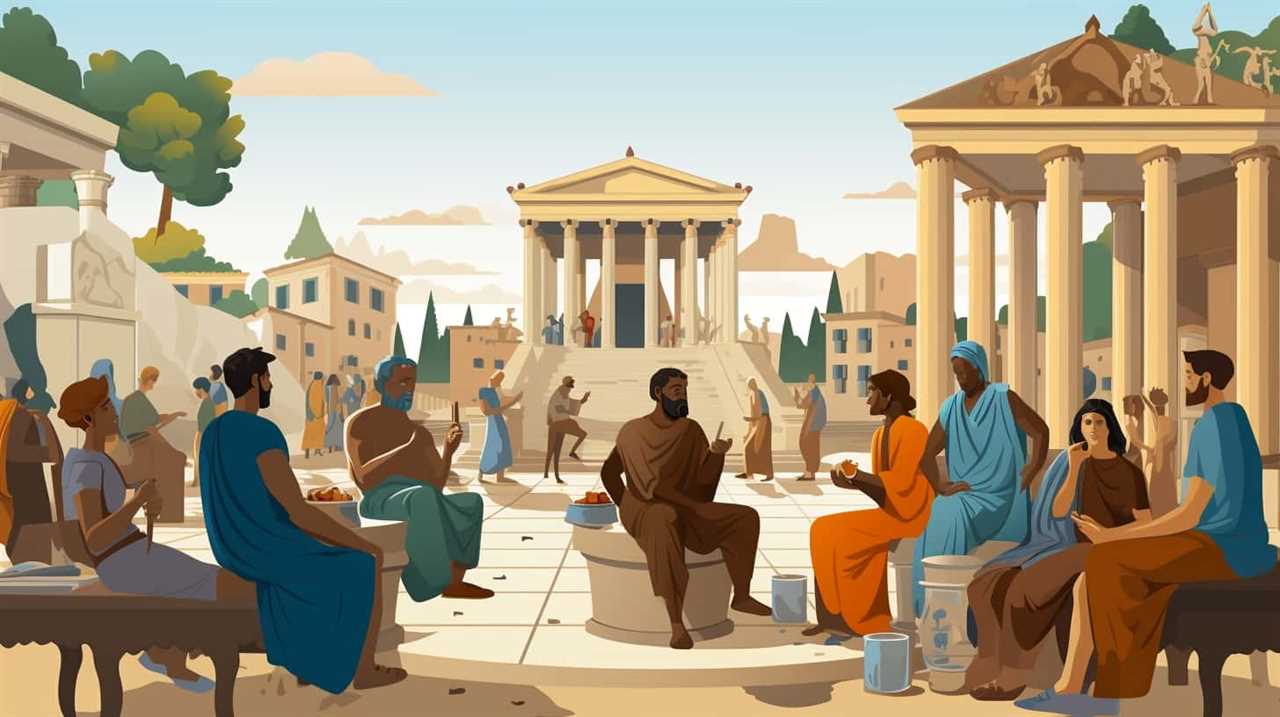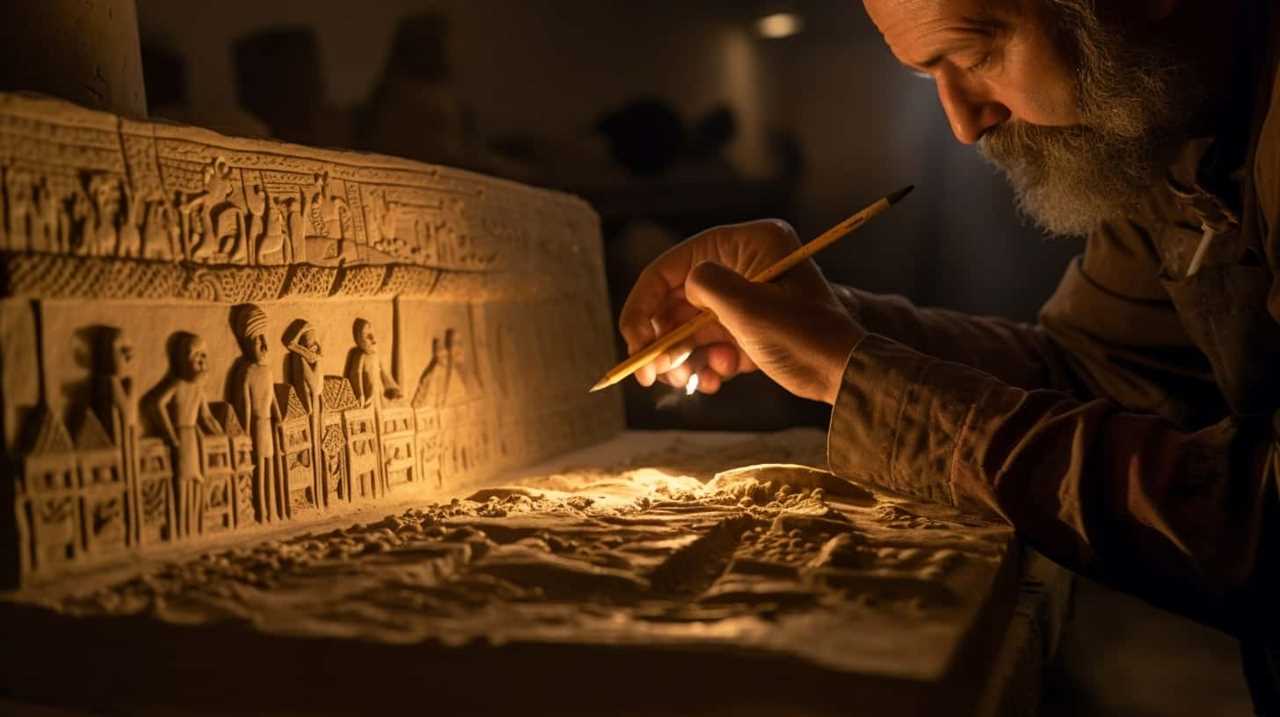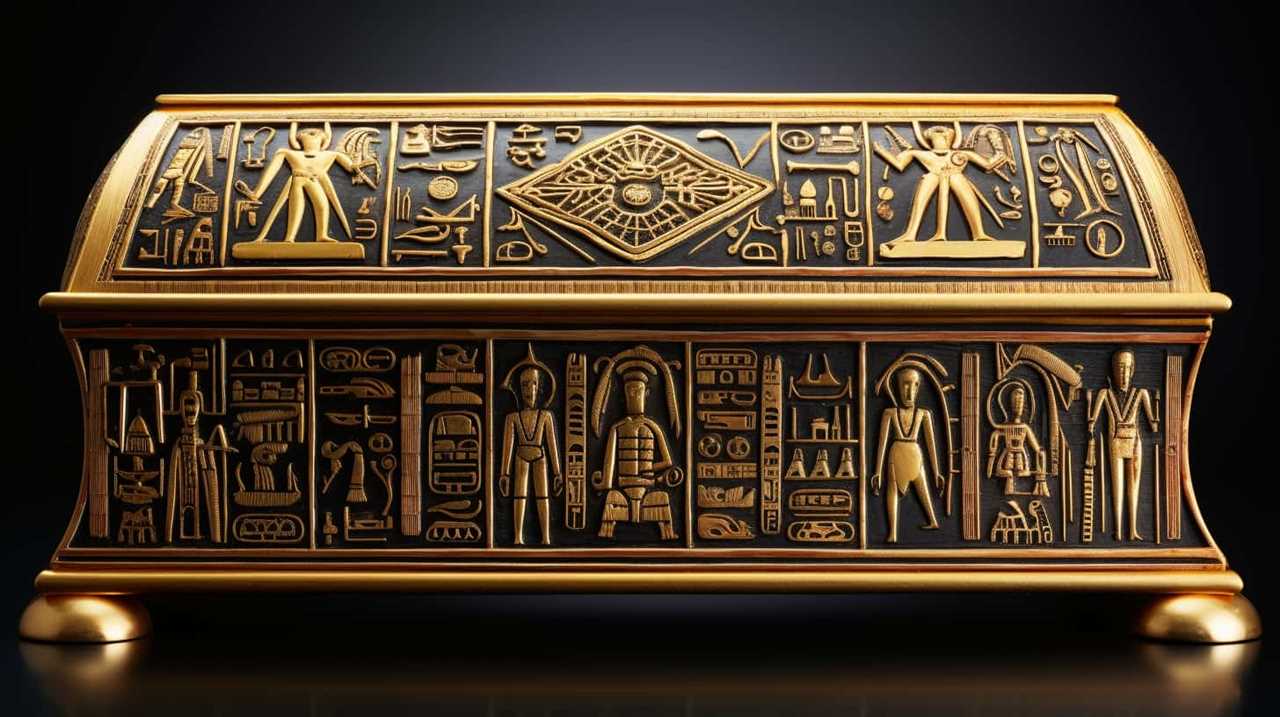Welcome to our guide on interpreting Mesopotamian clay tablet writings! We have created this comprehensive tutorial for those who are keen to enhance their understanding of these ancient inscriptions.
In this guide, we will delve into the historical significance of Mesopotamian clay tablets, explore the intricacies of the cuneiform writing system, and address the challenges that arise in translating these inscriptions.
We will provide you with key tools and resources necessary for successful translation, as well as a step-by-step guide to help you navigate the process.
Additionally, we will discuss common misinterpretations and offer valuable insights on how to avoid them.

Get ready to unlock the secrets of the past as we embark on this fascinating journey together!
Key Takeaways
- Mesopotamian clay tablet inscriptions are valuable for understanding the historical context and cultural implications of ancient Mesopotamian civilization.
- Deciphering cuneiform writing requires expertise in ancient languages and scripts, as well as an understanding of the materials used and origins of the script.
- Clay was the primary writing material used in Mesopotamia due to its abundance and malleable nature, providing a durable and long-lasting medium for recording information.
- Translating Mesopotamian inscriptions poses challenges such as linguistic evolution, lack of known phonetic systems, and the need for cultural context to avoid misinterpretation.
Historical Significance of Mesopotamian Clay Tablets
The historical significance of Mesopotamian clay tablets lies in their preservation of ancient knowledge and insights into the development of civilization. These tablets provide us with a valuable glimpse into the historical context of the ancient Mesopotamian civilization and their cultural implications.
The clay tablets were used by the Mesopotamians to record various aspects of their lives, including administrative, legal, religious, and literary texts. Through the study of these tablets, we’re able to understand the social, economic, and political structures of this ancient civilization.
The clay tablets also shed light on the cultural practices, beliefs, and traditions of the Mesopotamians. They provide us with valuable information about their religious rituals, mythologies, and literary works. For example, the Epic of Gilgamesh, one of the oldest surviving works of literature, was written on a series of clay tablets.

Furthermore, these tablets have allowed us to trace the development of writing systems. The Mesopotamians used a script known as cuneiform, which consisted of wedge-shaped marks made on clay tablets. The deciphering of this writing system has provided us with a wealth of information about the ancient world.
In the subsequent section, we’ll explore the process of deciphering the cuneiform writing system and the challenges involved in understanding these ancient inscriptions.
Deciphering Cuneiform Writing System
Now let’s explore the fascinating world of deciphering the ancient cuneiform writing system.
Cuneiform script, which originated in Mesopotamia around 3200 BCE, was one of the earliest writing systems in the world. It was primarily impressed onto clay tablets using a stylus, creating wedge-shaped marks that gave the script its name.

Understanding the materials used and the origins of this script is crucial to unlocking the secrets of the Mesopotamian clay tablet inscriptions.
Cuneiform Script Origins
To understand the origins of the cuneiform writing system, we delve into the development and decipherment of this ancient script. The cuneiform script, which emerged in ancient Mesopotamia, is considered one of the earliest forms of writing and played a crucial role in the evolution of writing systems.
Here are three key points to consider:
- Earliest Beginnings: The cuneiform script can be traced back to around 3200 BCE when people in ancient Mesopotamia first began using pictographs to represent objects and ideas.
- Evolution of Writing: Over time, these pictographs evolved into a more abstract form, known as proto-cuneiform, which consisted of wedge-shaped impressions made on clay tablets using a stylus.
- Standardization and Decipherment: By the third millennium BCE, the cuneiform script had become standardized and was used for administrative, legal, and literary purposes. Its decipherment in the 19th century CE by scholars like Henry Rawlinson and others unlocked a wealth of knowledge about ancient Mesopotamia.
Studying the origins of the cuneiform script allows us to gain insights into the development and evolution of writing systems throughout history.

Writing Materials Used
In our journey to decipher Mesopotamian clay tablet inscriptions, let’s explore the writing materials used, specifically focusing on the significance of clay as a medium for the cuneiform writing system.
Clay was the primary writing material utilized by ancient scribes in Mesopotamia. This choice wasn’t arbitrary, but rather a result of practical considerations as well as cultural significance. Clay was abundant in the region, making it readily available and cost-effective. Its malleable nature allowed scribes to easily inscribe the wedge-shaped characters of cuneiform script using a stylus.
Furthermore, clay tablets provided a durable and long-lasting medium for recording important information, such as legal documents, administrative records, and literary texts. The clay tablets were then hardened by sun-drying or baking, ensuring their preservation for centuries to come.
Understanding the unique properties and cultural significance of clay as a writing material is essential in deciphering the ancient script and unraveling the secrets of Mesopotamian civilization.

Challenges in Translating Mesopotamian Inscriptions
When it comes to translating Mesopotamian inscriptions, we’re faced with several challenges. One of the main difficulties lies in understanding the language and context in which these inscriptions were written.
Additionally, deciphering the ancient symbols used in cuneiform writing poses another obstacle. These challenges require careful analysis and expertise in ancient languages and scripts to ensure accurate translations.
Language and Context
One of the challenges we face in translating Mesopotamian inscriptions is deciphering the complex language and understanding the historical and cultural context in which they were written. The evolution of the Mesopotamian language over time adds another layer of complexity to the translation process. Additionally, the cultural context in which these inscriptions were produced is crucial for accurately interpreting their meaning. To shed light on this challenge, we must consider the following:
- Language Evolution: The Mesopotamian language underwent significant changes throughout its history, making it difficult to decipher older texts. We must continually study and compare different linguistic stages to grasp the intricacies of these inscriptions.
- Cultural Context: Understanding the cultural practices, beliefs, and social structures of the Mesopotamian civilization is essential for accurately interpreting the inscriptions. Without this context, we risk misinterpreting their intended meaning.
- Historical Significance: Translating Mesopotamian inscriptions requires a deep understanding of the historical events and period-specific knowledge. This knowledge helps us contextualize the inscriptions within the broader historical narrative.
As we navigate the complexities of language evolution and cultural context, our next challenge lies in deciphering the ancient symbols themselves.

Deciphering Ancient Symbols
To better understand the complexities of translating Mesopotamian inscriptions, we must now delve into the challenges of deciphering the ancient symbols they contain.
These symbols were created using ancient writing methods that differ greatly from modern languages. One of the main difficulties in deciphering these symbols is the lack of any known phonetic system. Unlike alphabets that represent specific sounds, the symbols used in Mesopotamian inscriptions often represent entire words or concepts.
Deciphering these symbols requires a meticulous process of linguistic analysis, comparing the inscriptions with known texts and languages. Scholars must carefully study the context in which the symbols are used, identifying recurring patterns and deciphering the meaning behind them.
By unraveling the mysteries of these ancient symbols, we can gain valuable insights into the civilizations that once thrived in Mesopotamia.

Transitioning into the next section, let’s now explore the key tools and resources that aid in the translation of these inscriptions.
Key Tools and Resources for Translation
We have found several essential tools and resources that greatly aid our translation process of Mesopotamian clay tablet inscriptions. These tools and resources have been instrumental in our efforts to decipher the ancient symbols and unlock the secrets of this ancient civilization.
Here are three key tools and resources that have proven to be invaluable:
- Lexical and grammatical dictionaries: These dictionaries provide us with a comprehensive understanding of the vocabulary and grammar of the Mesopotamian language. They help us identify the meanings of individual words and their contextual usage, enabling us to construct coherent translations.
- Bilingual texts: The availability of bilingual texts, where the same text is written in both Mesopotamian and a known language like Akkadian, greatly aids our translation process. By comparing the two versions, we can identify patterns, analyze grammar, and establish correspondences between the two languages.
- Digital databases and corpora: With the advent of technology, digital databases and corpora have revolutionized our translation work. These repositories contain a vast collection of Mesopotamian texts, making it easier for us to compare and cross-reference different inscriptions. Additionally, the search functions within these databases allow us to quickly locate specific words or phrases, saving us valuable time and effort.
Translating Mesopotamian Inscriptions: Step-by-Step Guide
Our approach to translating Mesopotamian inscriptions involves a systematic and methodical analysis of the symbols and their contextual meanings. We employ various translating techniques to decipher the ancient script, taking into account the linguistic challenges presented by the unique nature of the cuneiform writing system.

One key technique is comparative analysis, where we compare the symbols in the inscriptions with known texts and linguistic patterns from the same time period. This helps us identify recurring symbols and their potential meanings. Additionally, we utilize linguistic analysis to study the grammar and syntax of the inscriptions, allowing us to piece together the structure and flow of the text.
To illustrate the complexity of translating Mesopotamian inscriptions, consider the following table:
| Symbol | Contextual Meaning | Possible Interpretation |
|---|---|---|
| 𒀭 | God | Enlil |
| 𒁹 | King | Hammurabi |
| 𒄑 | City | Babylon |
By carefully analyzing the symbols and their contextual meanings, we can uncover the historical and cultural significance embedded in the inscriptions.
As we delve into the next section on common misinterpretations and how to avoid them, it is important to keep in mind the intricacies of translating Mesopotamian inscriptions.

Common Misinterpretations and How to Avoid Them
As we frequently encounter common misinterpretations, it’s important for us to be aware of how to avoid them when translating Mesopotamian clay tablet inscriptions. Understanding the nuances in translation is crucial to accurately deciphering these ancient texts.
Here are three common misconceptions and how to avoid them:
- Literal translations: It’s easy to fall into the trap of translating word-for-word without considering the context and cultural background. To avoid this, we must strive for a dynamic equivalence that captures the meaning and intent behind the words.
- Ignoring cultural references: Mesopotamian inscriptions are rich in cultural references that may not have direct equivalents in modern languages. It’s essential to familiarize ourselves with the cultural context to avoid misinterpretations and ensure accurate translations.
- Overlooking linguistic variations: Mesopotamian clay tablet inscriptions span a significant period, and the language evolved over time. Neglecting linguistic variations can lead to misinterpretations. By understanding the linguistic changes and using appropriate dictionaries and resources, we can ensure accurate translations.
To avoid these common misinterpretations, we must approach the translation process with a deep understanding of the language, culture, and historical context. By being mindful of these nuances and employing a comprehensive methodology, we can unravel the mysteries of Mesopotamian clay tablet inscriptions with precision and mastery.
Frequently Asked Questions
How Were Mesopotamian Clay Tablets Discovered and Preserved Over Time?
We discovered and preserved Mesopotamian clay tablets through various discovery methods and preservation techniques. These methods allowed us to uncover and protect these invaluable artifacts, ensuring their longevity and enabling us to study ancient Mesopotamian civilizations.

What Were the Primary Purposes of Mesopotamian Clay Tablets?
The primary functions of Mesopotamian clay tablets were as records, legal documents, and administrative tools. The significance of these inscriptions cannot be overstated – they provide us with valuable insights into ancient civilizations, like a time capsule unlocking their secrets.
Are There Any Known Limitations or Gaps in Our Understanding of Mesopotamian Clay Tablet Inscriptions?
There are limitations and gaps in our understanding of Mesopotamian clay tablet inscriptions. Further research is needed to fill these gaps and enhance our knowledge. Context is crucial for accurate translation and interpretation.
How Do Scholars Determine the Age and Authenticity of Mesopotamian Clay Tablets?
To determine the age and authenticity of Mesopotamian clay tablets, scholars employ various methods of analysis. These include examining the materials used, studying the writing style and language, and comparing the tablets to known examples from the same time period.
How Has the Translation of Mesopotamian Clay Tablets Contributed to Our Understanding of Ancient Mesopotamian Culture and History?
The translation of Mesopotamian clay tablets has greatly impacted our understanding of ancient Mesopotamian culture and history. It has provided us with valuable insights into their language, beliefs, social practices, and historical events.

Can You Provide Translations for Specific Mesopotamian Clay Tablet Inscriptions?
Yes, we can provide translations for specific Mesopotamian clay tablet inscriptions. Our team of experts specialize in deciphering and translating ancient Mesopotamian clay tablet inscriptions, offering valuable insights into the rich history and culture of the region. Contact us for accurate and reliable translations.
Conclusion
In conclusion, the translation of Mesopotamian clay tablet inscriptions is a complex and fascinating field of study. Despite the challenges faced in deciphering the cuneiform writing system, scholars have made significant progress in understanding the ancient texts.
One interesting statistic is that over 500,000 cuneiform tablets have been discovered so far, providing a wealth of information about the history, culture, and daily life of the Mesopotamian civilizations.
The meticulous work of translators ensures that these invaluable insights aren’t lost to time.
Fritz is a writer whose humor and wit infuse life into words. His creativity, combined with a profound love for the English language, makes him a unique voice at afterQuotes. Fritz’s engagement with books, culture, and social media adds depth to his contributions, making them resonate with our diverse audience.










